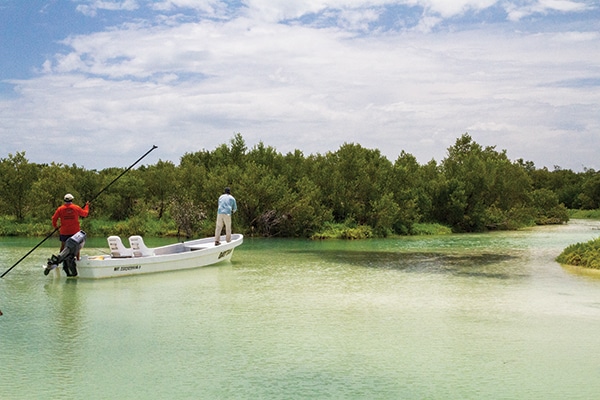
The bustle of vacationers headed for attractions and beach hotels, eco-tourists and zip-liners quickly fades as you escape Cancun and the two-lane road carries you into the selva, the low scrub jungle that blankets the Yucatan Peninsula. The thatched huts of the Maya sit in occasional roadside clearings, and towns are small and few.
A two-hour drive brought us to the village of Chiquila, and a short ferry ride from there delivered us to the town dock at Holbox — a Mayan name pronounced hole-bosh — where high-rise development has yet to take root, and barely off the beach lies the migration route of giant tarpon as they round the peninsula.
On the Map
Jay Nichols, from Boiling Springs, Pennsylvania, and I had met up for a fast tour of the fishing at Holbox Island. Holbox has been on the angling map for more than a decade as a dependable intercept for migrating giant tarpon, a complement to the baby-tarpon fishery that predominates in the Yucatan. Just 8 miles from town, in 20 to 30 feet of water, rock and coral grottoes form natural travel paths for immense schools of anchovies — and the fish that feed on them. From April through September, tarpon move through this inshore slot, traversing between the northern Caribbean and the southern Gulf of Mexico.
The tarpon fishing here is straightforward: It’s not always easy, but giant tarpon seldom are. The routine, however, is quite simple. Our guide, Darwin Vega, picked us up on the beach before sunup. A 7- or 8-mile run put us on the numbers in Vega’s GPS, in places where he consistently catches fish. A glance at a chart is enlightening: We concentrated our efforts in 20 to 30 feet of water, with large outcroppings of coral and rock rising 8 to 10 feet off the bottom — a natural route for bait and migrating fish.
As the sun came up, we started to see the bait. Schools of anchovies looked like cloud shadows on the surface, generally an acre or two in size. At any given time, we could see six or eight of these schools around us.
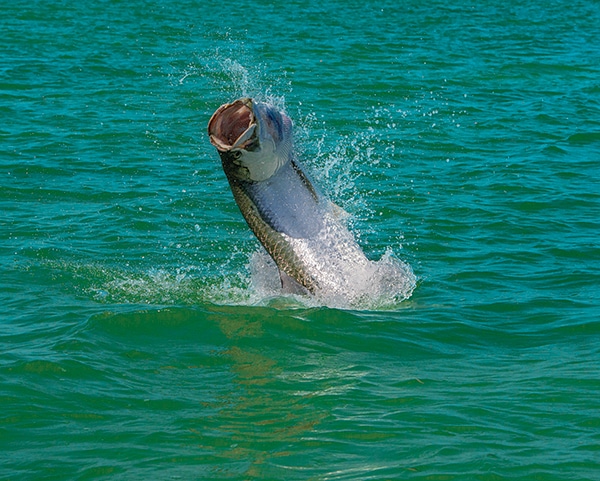
Hunt ‘Em Up
The hunt for tarpon amounts to motoring around** in a panga, watching for rolling fish. The setting for this tarpon fishing lies somewhere between the shallow-water sight-fishing in the Florida Keys and the deepwater river-mouth fishing off Costa Rica. The water at Holbox is clear and green, the bottom often visible from the surface. But the fish have to be rolling for you to see them. Once they show, the guides idle around and in front of the moving fish, giving them a wide berth. Once they are in front of the pod, they shut down the motor and paddle the boat into position to give anglers an advantageous shot at the approaching fish.
Like tarpon everywhere, some days they are rolling and some days they are not. When the fish are high in the water and rolling regularly, fishing can be epic. When they are staying deep, all you can do is wait, look and hope.
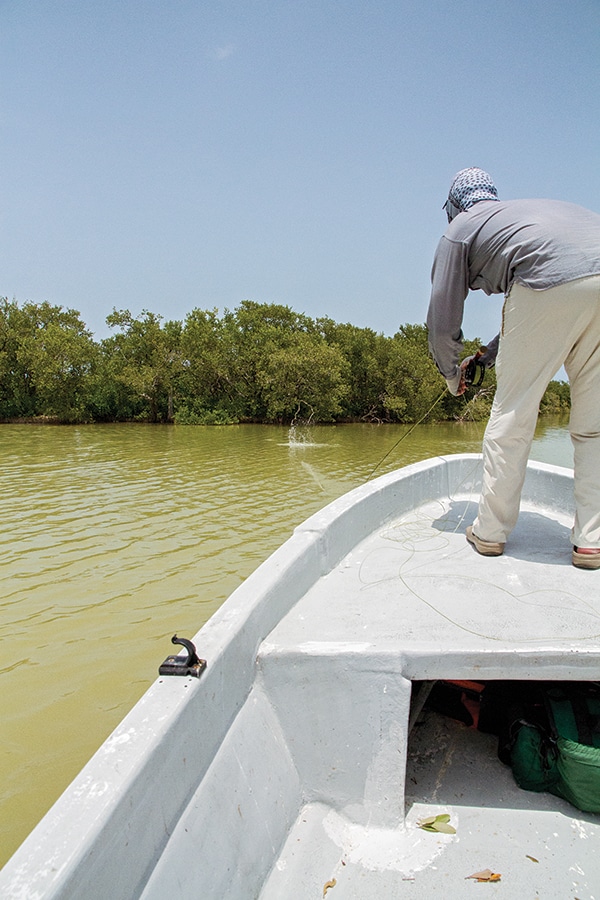
Little Brothers
The first day we saw few tarpon rolling; the wind picked up, fueled by storms that threatened over the Caribbean. After battling the conditions, we fell back to another attractive option and ran to the south side of the island to fish baby tarpon in the mangroves.
Despite the weather, there’s scarcely a time when this is not an option at Holbox. The worse the weather gets, the farther back into the mangroves you can push — the fish are there, and are willing eaters. They won’t provide the same adrenalin rush and athletic workout as the giants, but they are plenty of fun on 12-pound casting tackle and 8-weight fly rods. And inch for inch, they jump higher and a lot more energetically than their big brothers.
The babies, running from 8 to 30 pounds, range from the broad marl flats that stretch into the Laguna Yalahau to the mangrove creeks that snake through the island, offering a variety of fishing conditions and casting challenges. In our case, they proved a successful day-saver, a reliable bonus on any tarpon expedition. A few tarpon in the 10- to 20-pound range is always an acceptable consolation when the ocean is getting blown out.
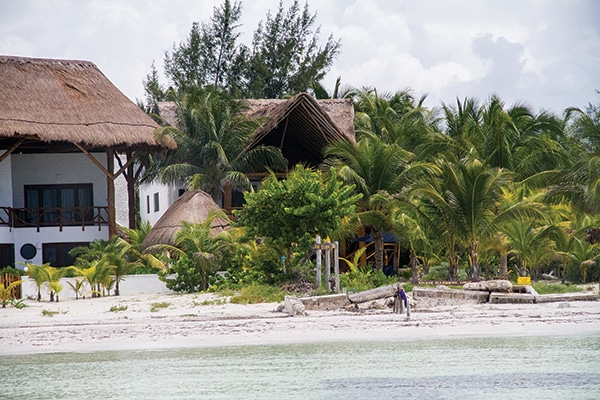
Big Silver
The next morning we caught a break, both in luck and the weather. We hadn’t been cruising the tarpon grounds long when Vega spotted a rolling fish. Fortunately, Nichols spotted it too. Unfortunately, it was Nichols’ turn on the casting deck, not mine. He laid out a 75-foot cast in the tarpon’s apparent path, and almost immediately his line straightened and began burning off the reel. The 75-pounder took the fight aerial, went long, and took to the air again, amazingly strong given the warm water temperatures. A classic 20-minute battle ensued before the fish rolled boat-side, and the leader hit the tiptop, solidifying an official catch — just in time for the seas to kick up.
We continued cruising the bait schools, as visibility waned and conditions worsened, but this time, acquainted with the search game, we put out some swimming plugs and trolled them in our wake. What we found were not tarpon but a variety of reef species ready and willing to hit our lures; snapper and mackerel came steadily over the gunwales, and kept pretty interesting what was rapidly becoming tough fishing.
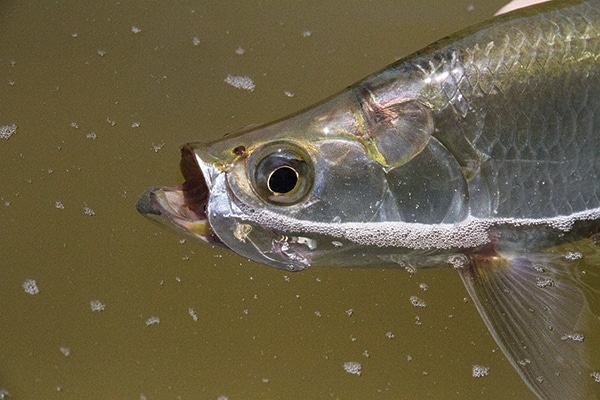
It’s All Good
We knew we had an ace to fall back on, and it wasn’t long before we headed to where conditions were likely right for some fast, if not giant, tarpon fishing. It was good to have the option, and once again, we headed for the mangroves.
Perhaps the best aspect of tarpon fishing in Holbox is that it is not, like tarpon fishing in many other places, an all-or-nothing place. Some days are red hot, and big fish will hit just about anything you cast to them. For this reason, it’s a place many anglers return to year after year. Some days, between waves of migrating fish, or when it weathers up, it’s like tarpon fishing in most places: tough, with few shots and lots of hunting. But, when it’s like that, there are options. And perhaps most alluring of all is the slower pace and relaxed atmosphere — yes, even in the giant-tarpon fishing — in a remote and beautiful place that shows you the best of what Mexico has to offer









